Nicolò Circignani was born at Pomarance, near Volterra and is known as il Pomarancio. He shares this nickname with two artists who trained under him:
-
✴his son Antonio Circignani; and
Nicolò Circignani is first documented in 1564, when he was living in Città della Pieve and enjoying the patronage of Ascanio della Corgna. He signed a partnership agreement with Arrigo Fiammingo (Hendrik van den Broeck) in Perugia later that year. He took over a commission that Arrigo Fiammingo secured in 1565 for an altarpiece in the Duomo, Orvieto (see below). Both artists worked on the frescoes of the Santuario di Mongiovino at Panicale, near Lake Trasimeno. His marriage took place in Città della Pieve in 1567. He worked in Città di castello for a period in the 1570s, and was granted citizenship in 1577.
Nicolò Circignani spent the 1580s working mostly in Rome. His last known work is in Cascia (see below).
His followers included Avanzino Nucci.
Cascia
Ascension (1596)
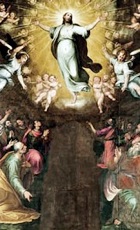
Città di Castello
Nicolò Circignani received citizenship of Città di Castello in 1577.
Panels in San Francesco
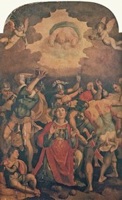
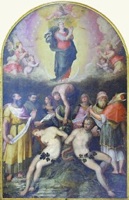
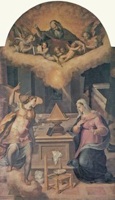
Martyrdom of St Stephen (1570) Immaculate Virgin (1573) Annunciation (1570)
From 1st altar on right Documented (1728) From 3rd altar on right
in right transept
These three panels from San Francesco are all signed by Nicolò Circignani and dated by inscription. They were all documented in the civic collection in 1878 and are now in the Pinacoteca Comunale.
The composition of the panel of the Immaculate Conception is derived from that of a panel (1540) by Giorgio Vasari from SS Apostoli, Florence, which is now in the Ashmolean Museum, Oxford. The Immaculate Virgin is depicted triumphing over original sin. Adam and Eve are bound to the Tree of Knowledge below and flanked by figures from the Old Testament.
Massacre of the Innocents (1570-1)
Surviving documents record that Pompeo Tiberti commissioned this altarpiece from Nicolò Circignani in 1570 for his chapel in Sant’ Agostino, and that its price was agreed after its completion in the following year. The local art historian Giacomo Mancini reported that, during an apostolic visit in 1571, Monsignor Paolo delle Rovere had tried unsuccessfully to prevent its exposure in the church because of the “obscene nudity of some of the figures”. It survived the earthquake of 1789 and the depredations of French soldiers in 1798, and was still in place in 1807, when the friars sold it to Mancini himself. It is now in the Galleria Nazionale d’ Arte Antica, Palazzo Barberini, Rome, and has recently been restored.
Frescoes of Palazzo Vitelli a Porta Sant' Egido (1572-4)
In 1571, Paolo Vitelli commissioned the Bolognese artist Prospero Fontana to lead a team of artists on the frescoes of Palazzo Vitelli a Porta Sant' Egidio, which were to be completed in time for a visit by Ottavio Farnese, Duke of Parma. Although mostly the work of Fontana himself, some can be attributed to younger members of his team, including Nicolò Circignani.
Madonna and Child with Saints (1577)
This altarpiece on the right wall of the church of the Abbazia di San Salvatore di Monte Corona, which is dated by inscription, is attributed to Nicolò Circignani. It probably came from the parish church of Romeggio, which belonged to the abbey. It depicts the Madonna and Child, seated on a cloud, with St Peter and a papal saint to the sides.
Transfiguration with Saints (1578)
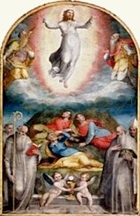
-
✴St Benedict, who reads from the Rule that he devised for his Order; and
-
✴St Romuald, who holds a model of the complex on Monte Corona.
Madonna and Child with saints (1577)
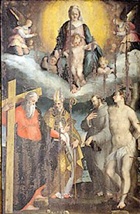
Annunciation (ca. 1595)
This altarpiece by Nicolò Circignani in the Cappella Guazzini in the Duomo was stolen in 1809 and has never been recovered.
Conversion of St Paul (16th century)
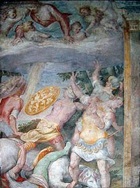
[Have some of the other frescoes in this cycle been recovered?]
Foligno
Veronica (1558)
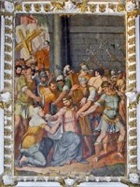
Adoration of the Magi (1567)
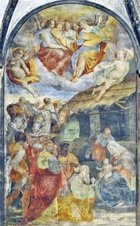
Orvieto
Christ healing a Cripple (1565-6)
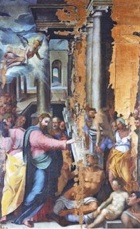
Nicolò Circignani was duly commissioned to execute the frescoes of the Cappella di San Nicolò, (the 3rd on the left). He subsequently also painted its altarpiece (1566), which depicted Christ healing a Cripple. The chapels were destroyed in ca. 1890: the altarpieces, including this one by Nicolò Circignani, are now in the Museo dell’ Opera del Duomo.
Perugia
Frescoes (1568)
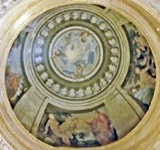

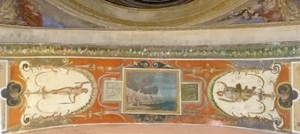
The frescoes in the cupola of the ex-church of the Maestà delle Volte are signed by Nicolò Circignani and dated by inscription. The main fields depict scenes from the Book of Genesis, and include this one of the creation of Eve. The commission was part of the renovation of the church commissioned by Cardinal Fulvio della Corgna.
Spello
Scenes from the life of St Laurence (1566-77)
These six panels were commissioned to form a frieze under the organ in San Lorenzo. One of them, which depicts the martyrdom of St Laurence, is signed by Nicolò Circignani and dated by inscription. They are now in the sacristy of the church.
Read more:
C. Galassi, “Niccolò Circignani il Pomarancio: Prattico e Spedito Pittore", (2007) Città di Castello
G. Sapori, “Artisti e Commitenti sul Lago Trasimeno", Paragone 33:393 (1982) 27-61
Return to Art in: Cascia Città di Castello Foligno Orvieto Perugia Spello.
Return to “Foreign” Painters in Umbria.



